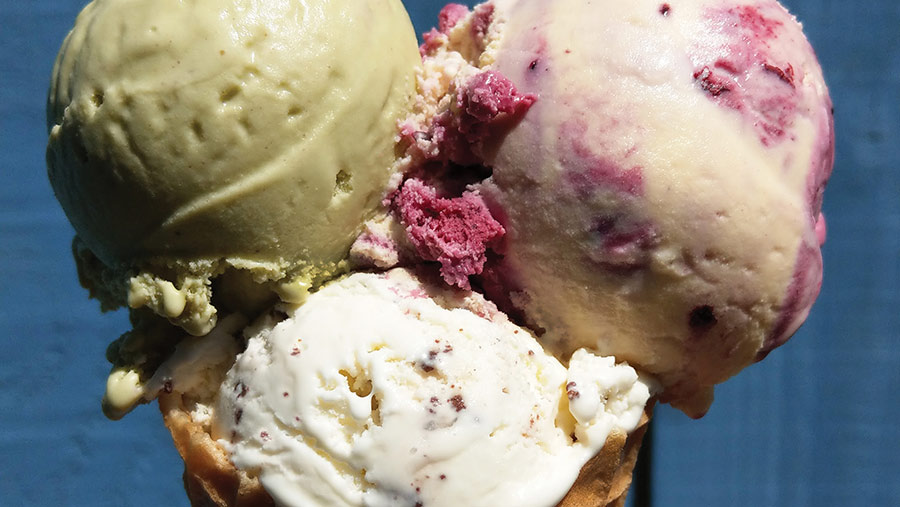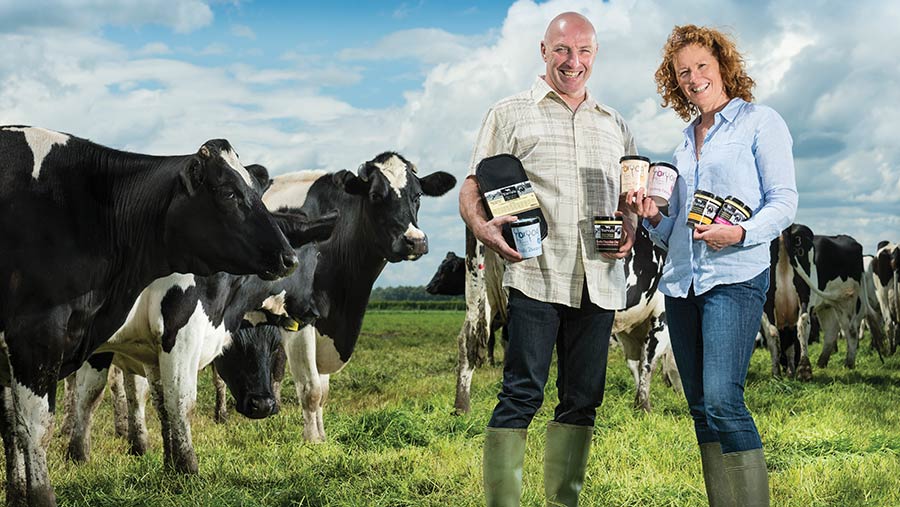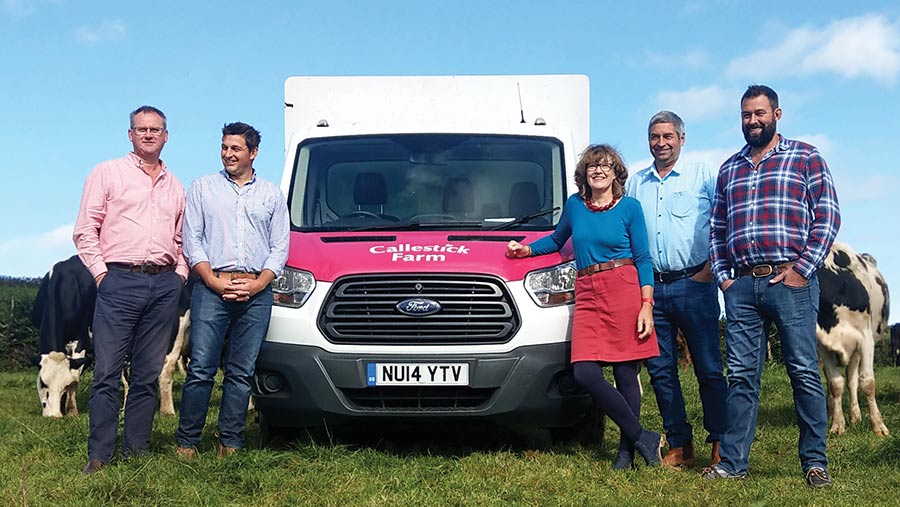So you want to…make and sell ice cream?

Adding value to fresh milk by turning it into ice cream is a popular and profitable enterprise for many dairy farmers.
With margins on ice cream sales up to 10 times those of milk sales, the opportunities in a growing market are endless for those prepared to invest in some training and equipment.
Farmers Weekly asked Zelica Carr, chief executive officer of the Ice Cream Alliance – the UK trade body for the ice cream industry – how to get started.
What’s the market like?
It is a booming sector in the UK. Ice cream parlour openings are up 20% year on year, according to international accountancy firm PwC.
See also: More diversification advice and case studies on fwi
Artisan is the buzzword in today’s food and drink sector, and it’s the most sensible and financially viable way to start.
It means producing ice cream in small batches (90 litres/hour) and using a range of flavours (as natural and local as possible), with emphasis on a freshly made product.
Many artisan ice cream makers do not sell their products through supermarkets, preferring to sell through smaller outlets such as farm shops, specialist ice cream parlours, local retailers, hotels and restaurants.
What do I need to know?
Before you start, contact your local environmental health office and local authority planning office to outline your intentions, [rest of this sentence print only] advises Zelica Carr, chief executive officer of the Ice Cream Alliance, the UK trade body for the ice cream industry.
You will need to register with the environmental health office and adhere to food manufacture and retailing codes of practice.
In some cases planning permission is needed, although this depends on the scale of the operation.
If you intend to produce ice cream to supply to a wholesaler, you will have to register as a dairy manufacturer.
The Ice Cream Alliance runs a series of training courses covering everything from health and safety to recipe development.
What equipment do I need?
There are two main pieces of equipment: a batch pasteuriser (which pasteurises and stirs the base mix ingredients) and a batch freezer (that churns the finished gelato).
The Ice Cream Alliance estimates a minimum set-up cost of about £15,000 for brand-new equipment. That would buy a 7kg capacity batch pasteuriser and a three-litre capacity batch freezer, capable of producing 100 litres of ice cream in an eight-hour day.
Higher throughputs will mean bigger price tags and will require a three-phase power supply – a 30-litre batch pasteuriser costs £13,000 and a 40 litre/hour batch freezer costs £18,000.
Second-hand equipment can be bought to get the business off the ground and some suppliers will take machinery back in part exchange when you are ready to expand.
A blast freezer will also be needed to rapidly cool the product post-freezing and a chest freezer to store the ice cream once it is frozen. Prices vary depending on capacity.
When starting up, some equipment manufacturers provide training for their machines.
Funding may be available through local groups or local authorities, depending on the region.
How can I attract customers?
Visit other businesses to see what flavours they are creating, how they are presenting them and how much they are charging.
Look at their packaging and marketing as well and do not be embarrassed to copy what you think is working.
Though by far the best-selling flavours are vanilla, chocolate and strawberry, one way to stick out from the crowd is to produce a range that is creative, innovative and different.
You will need to publicise your new venture. This does not need to cost a fortune, but will take some creativity and legwork.
Get some coverage in your local newspapers and magazines, get yourself on your local radio station and leaflet local homes and businesses. Organise an open day when you launch and give away some free samples.
What about insurance?
Farm insurance covers only for the business of farming, so you will need to take out cover for your stock and equipment. With diversification now so common, this can often be added to a farm policy.
It will be important to have product liability insurance to cover the business against any claims for injury or damage by your product, for example food poisoning.
Case study: Fossfield Farm

Ian and Lesley Buxton, both from non-farming backgrounds, took on a 32ha dairy farm tenancy through North Yorkshire County Council in 1984.
They bought a herd of pedigree Friesian cows and within a few years decided to try to add value to their current enterprise rather than moving to a larger farm, as the milk quota system at the time meant buying the extra quota would have cost too much.
Farm facts
- Fossfield Farm, York
- 32ha farm
- 40 milking Holstein Friesian cows with followers
- Selling ice cream, sorbet and kefir as Yorvale Ltd
- 20 full-time permanent staff
As a favourite dessert of the family, ice cream was chosen, and in 1989 Yorvale Ice Cream was born, using just a small production room, a basic recipe, milk from their herd, and double cream from a local dairy.
At first 12 basic flavours were produced, increasing to the current range of more than 30 flavours.
Planning permission for a farm shop was refused, leading to the Buxtons buying two mobile ice cream units in order to sell to the public.
In 1998, the family managed to buy Fossfield Farm from the council and in the time since have added a production unit with a pasteurisation room, manufacturing areas, cold rooms and freezers.
In 2005 the majority of the herd was sold, keeping just enough cows to supply the milk for the ice cream production.
During the past few years the Buxtons have added a drinking kefir and a non-dairy ice cream to their range and established delivery of their products into the food service industry across England.
“The most difficult part has been that when we sold milk to the dairies we had a regular milk cheque and once we stopped this we had to be totally sales-focused, which was a big learning curve,” says Mrs Buxton.
“Understanding and adapting to legislation changes has been a challenge too, but the best part has been seeing the business and our small team of young staff grow and become as passionate about the brand as Ian and I are.
“For anyone else looking to try it, make sure you have a good plan in place before you start and do your homework.”
Case study: Callestick Farm

Callestick directors (l-r): David Jeffs, Ben Parker, Angela Parker, Sebastian Parker and Sam Parker
Business at Callestick Farm is a true family affair. Simon and Judith Parker bought the farm in 1953 and when milk quotas caused a 10% drop in income in 1989, their son Sebastian and his wife Angela came up with the idea of making ice cream.
Angela attended a course in ice cream manufacturing at Reading University and since then the business has grown exponentially, with the farm now 10 times its original size.
Farm facts
- Callestick Farm, Cornwall
- 405ha farm
- 900 cows
- 1.1m litres produced a year
- 22 permanent members of staff and about 10 seasonal employees
Sebastian is the managing director of the ice cream brand, Angela is the product development director and their sons Sam and Ben work as agricultural and operations director, respectively.
The family also recruited sales director and executive board manager David Jeffs in 2018.
There was a demand for quality ice cream in the business’s early days, supported by the Milk Marketing Board’s campaign for ice cream made with dairy cream.
Both locals and tourists alike wanted a genuine Cornish product, which in time won multiple national awards.
Callestick’s products are served in Cornwall’s hospitals and schools, as well as hotels, cafes, restaurants and attractions nationwide.
Recent achievements include a landmark export deal with China in 2019 and a Caribbean-inspired range in collaboration with celebrity food entrepreneur Levi Roots. An organic dairy-free ice cream looks to be the next step.
In addition to farming and manufacturing, Callestick offers a free visitor experience that includes a children’s play and animal viewing area and an opportunity to watch products being made in the ice creamery, as well as an on-site tea shop.
“Looking back, one of the most difficult parts of the diversification was the cost of the constant investment in ice cream equipment and the plant – ice cream kit is very expensive, but it is a key factor for producing a great award-winning product,” say the Parkers.
“They say ‘every day is a school day’ and it has been an education over the past 30 years but a very enjoyable one and we would do it all over again if we had the chance.”
Tips:
- Try to find your best local markets as they are the most rewarding
- Develop your point of difference to attract customers
- Never lose sight of the bottom line. Remember, “turnover is vanity and profit is sanity!”
